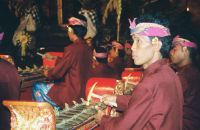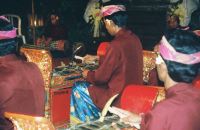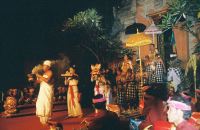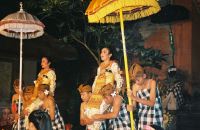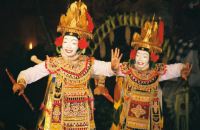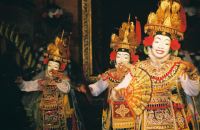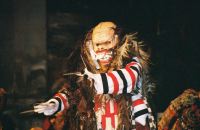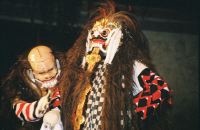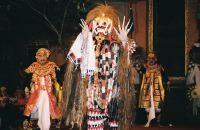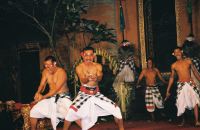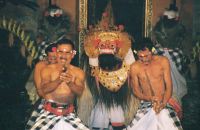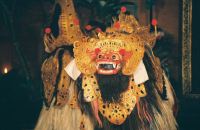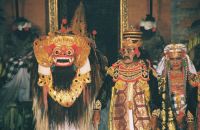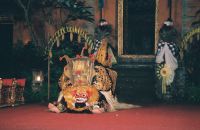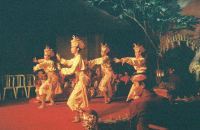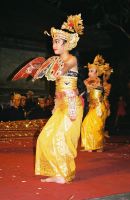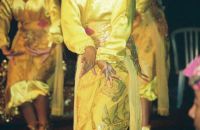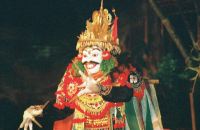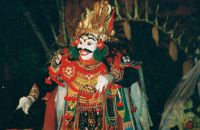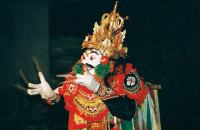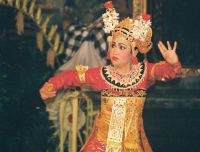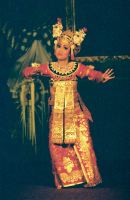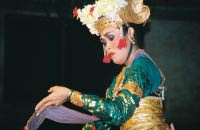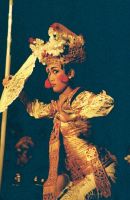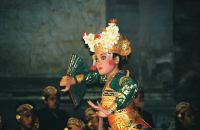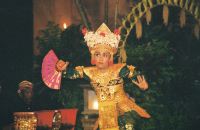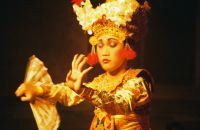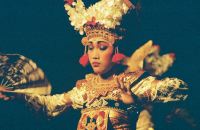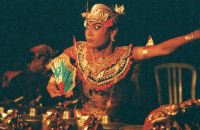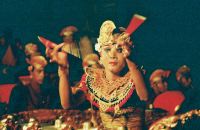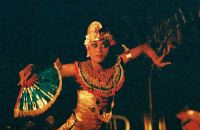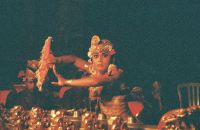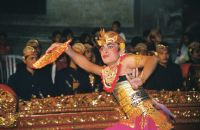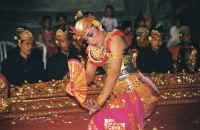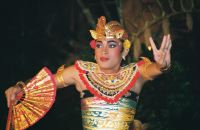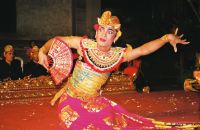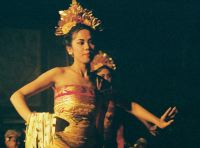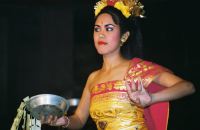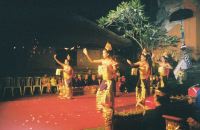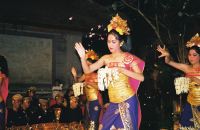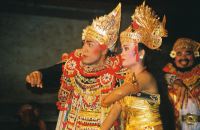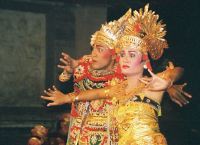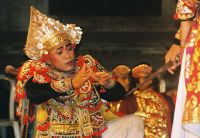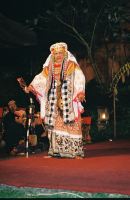After the Majapahit warriors subdued Ball in the 14th century, Javanese mini principalities and courts soon appeared everywhere, creating that unique blend occur and peasant culture, which is Bali highly sophisticated, dynamic and lively. The accompanying narrative for dance and drama is to a large extent based on court stories from pre-Majapahit Java. Even the Indian epics, another favorite of the stage, especially the wayang, use Javanese, complete with long quotes from the ancient Javanese Kakawin poetry. So Javanese culture, which disappeared from Java following Islamization in the 16th century still survived in Bali in a Balinese for which became classical ~Balinese culture. However, colonization brought about the fall of classical Bali. With the rural courts defeated and with new lords of the land, the centre of creativity shifted to village associations, and to the development of tourism. The 30's and 50's were particularly fertile decades; while the old narrative-led theater survived, lively solo dances appeared everywhere, accompanied by a new, dynamic kind of music called gong kebyar. This trend continued in the 60's and 70's with the creation of colossal sendratari ballets, representing ancient Indian and Javanese stories adapted to the needs of modern audiences. Source: Visitor Guide to Bali. | |||||||
|
Friday, August 22, 2008
Balinese Dances History
Bali Barong
It's the most popular dance for tourists. A straightforward battle between good, the barong, and bad, the rangda. The barong is a strange creature, half shaggy dog, half lion, propelled by two men like a circus clown-horse. The widow-witch rangda is bad though and certainly not the sort of thing you'd like to meet on a midnight stroll through the rice paddies.
The Barong dance is truly a triumphant display of bright colors and graceful movements. Greatly appreciated by the tourists, special performances are staged for their benefit, generally in the morning, and last one hour. The villages of Batubulan as well as Tegaltamu and Singapadu, small towns located 30 minutes from the capital, are known for putting on the best performances. There is, however, more to the Barong dance than the folkloristic dimension, It is, in fact, an integral part of the island's culture and has an evident sacred connotation. It isn't rare, in fact, to see the Balinese dancing the Barong during their religious ceremonies, regardless of the presence of tourists. Inspired by an episode taken from Mahabharata, an epic poem written in Sanskrit. the dance evolves around the character of the Barong, the king of the jungle. A mythical animal, not clearly identified (perhaps a lion), he is the symbol of virtue and good, subject to the continuous struggle against the evil forces that threaten life and the integrity of the forest, this being an element very dear to the Balinese population. In detail, the Barong embodies everything that can be beneficial to man, and help him defeat illness. black magic and any other kind of misfortune. The evil entity against which he must relentlessly fight is personified by Rangda, queen of death and devourer of children. She is characterized by a dark and gloomy mask from which a red tongue of fire hangs. The entire dance is centered around the struggle between these two rival characters. The Barong is interpreted by two dancers whose rhythmic movements bring to life the beautiful and elaborate cos tume they wear. a large animal head skillfully carved out of wood, brightly colored in red, white, black and gold. It is adorned with a crown extending outwards from the sides of the head, and by a prominent necklace which hangs from the neck, The final touch of the costume is a tail made out of bison leather which is elaborately finished and guilded. The first character to appear on the stage is the Barong with his swaying gait: his dance is meant to express the joy of living. He is followed by a group of armed supporters who stand ready to defend him.
When Rangda strikes her terrible blows. It isn't at all rare for the dancers playing the Barong's followers to become so engrossed in the sacredness of the per- formance that they go into a real trance. A cloud of characters surround the Barong on stage. Rangda, goddess of death, personification of evil, the young girl servant Kalika; Dewi Kunti, queen of the kingdom of Hastina and her stepson Sadewa who will be sacrificed in order to placate the anger of Rangda, the minister Dewi Kunti; Patih who ex- presses sorrow for the fate of Sadewa (Rangda will have to enter his soul in order to make him accept the sacrifice), and then the monkey supporters of the Barong, producers of palm tree wine (nira). A very important element in the entire dance is the large orchestra, known as gamelan, which is essential to underscore the ritual nature of the performance. Many are the instruments that make up the orchestra: some metal xylophones which stand out not only because they are so numerous but because of their power ful and imperious sound; there are also drums as well as flutes, the rebab (a type of violin) and the gender (typical xylophones). All together, these instruments are essential in guiding the dance and underscoring the rhythm of well coordinated movements. These along with the joyful colors are the most alluring elements of this remarkable perfor mance. At the end of the dance, the masks of the Barong and of Rangda, as proof of their sacred nature, are stowed in a special room inside the temple. They are covered very carefully, especially Rangda's mask, because its deadly powers are greatly feared. It's a way of saying that the ritual victory of the Barong, that is of good, which marks the end of the dance, is only temporary: tomorrow the eternal and unresolved conflict could begin again.
The end of the Barong dance is like an entirely separate performance. Also known as the Kris dance, it is named after the famous Malese dagger. The idea is based on the philosophical concept rwa bhineda. good and bad, evil and goodness which have always been present and have always existed together albeit in a constant and inevitably unre solved conflict. Nothing will change in the future. While man is left free to try to develop his positive attitudes and let them win over the negative ones, he must nonetheless resign himself to the fact that the presence of both good and evil is a law of nature and as such must be accepted. When the dance is performed, Rangda is the evil spirit which enters the bodies of his victims, usually followers of the Barong, and pushes them to the edge of suicide. The dancers attempt to stab themselves in the chest with their krises until they are finally stopped by the beneficial appearance of the Barong. It is he who will save these unfortunate beings by revealing that the notion of good and evil will always be inevitably present in the world and in everyone's life and that they must therefore accept it.
Sunday, August 17, 2008
Dance & Drama in Bali
Dance is the main art form of Balinese culture and is performed at main temple festivals and ceremonies, especially for the cycle of life and death. Taught and kept in secrecy in villages, halls and palaces, the dances that tourists witness in hotels and specially constructed stages are merely a fraction of the dance scene, although most of the dancers come from village groups.
The Kecak Dance
Its name is derived from the sound "cak", pronounced "chok", which is chanted in complex interlocking patterns that are like the rhythmic patterns played on the gamelan. The modern form of kecak originated from Gianyar village of Bedulu in the 1930s as a result commissioned by the German expatriate artist, Walter Spies. He wished to create a performance that could be enjoyed by a small coterie of expatriate artists like himself, as well as friends and guests to the island.
The modern performance of Kecak is a sensational sight to behold. Hundreds of barechested men sit in a circle with a flickering single oil lamp in the middle. "Cak - Cak - Cak", the chant begins and the men start dancing and swaying to the rhythmic reverberation of their own voices. Hands raised to the sky, bodies shaking in unison, the chorus performs the highly structured piece of vocal music for about an hour. This unique dance holds the title of being the most popular dance in Bali.
The Barong Dance
"Lord of the forest" and magical protector of Balinese villages, the Barong is a mythical, shaggy half-dog, half-lion creature, with a long mane, fantastic fangs, and bulging eyes. It is propelled by two men who maneuver the costume with whimsical and mischievous movements to express its fun-loving nature. The Barong's opponent is Rangda, the evil witch who rules over the spirits of Darkness. The Barong dance epitomizes the eternal struggle between good and evil. The fight of Barong and Rangda is also a topic of traditional narratives performed in temples and takes various forms. The Barong will snap its jaws at the gamelan, prance around a bit, and enjoy the acclaim of its supporters - a group of kris-wielding men. Then ferocious Rangda will then appear lolling her long tongue, baring her threatening fangs, her neck draped with human entrails...not a pretty sight.
The duel begins. Each opponent tries to overcome the other with magical powers but when things do not look too good for the Barong, supporters will lunge at Rangda with krises to weaken or stall her. In retaliation, Rangda would put them all into a trance with her mystical powers and make them stab themselves with their weapons. Fortunately, the Barong possesses magic that is strong enough to cast a spell on the krises from harming the men. This part would be the highlight of the dance; the gamelan rings madly and intensely as the men rush back and forth waving their krises in a frenzy, sometimes even rolling on the ground in a desperate attempt to stab themselves. Often, there seems to be a plot to terrify the audience in the front row! Eventually, Rangda will retire, defeated. And once again, good will reign over evil.
Legong Keraton
The most graceful of Balinese dances, this is the epitome of classical Balinese female dancing. A legong, as the dancer is known, is often a young girl of eight or nine years, rarely older than her early teens. It was first created in the 18th Century and is usually the first dance to be taught to beginners. There are many forms of Legong, the most frequently performed dance being the Legong Keraton or Legong of the Palace.
The story of the Legong is very stylized and symbolic and one should know the story before actually watching the performance. The Legong involves three dancers - two legongs and their 'attendant', the condong. The legongs are identically costumed in gold brocade, which is bound so tightly that it is a mystery such agitated and rapid moves could be made. With elaborately made-up faces, plucked eyebrows that are boldly repainted, and hair decorated with frangipanis, the dancers relate the story with captivating movements.
A king takes the maiden Rangkesari captive. When her brother comes to release her, Rangkesari begs the king to free her rather than go to war. The king refuses and chances upon a bird carrying ill omens on his way to battle. However, he ignores the bird, meets Rangkesari's brother, and was thus killed in the fight.
The roles of the dancers may change according to the narration. However, the dance usually begins with the king's preparations for battle and ends with the bird's appearance.
Baris
A male equivalent of the Legong, Baris is a warrior's dance. Executed with energetic and warlike martial spirit, the Baris dancer has to convey the thoughts and emotions of a warrior preparing for action as well as confronting an enemy in battle. This dance is performed solo and requires great energy, spirit and skill. The warrior's changing moods have to be displayed through facial expressions and movements; he should be able to depict chivalry, pride, anger, prowess, and a little regret. Baris is said to be one of the most complex of all Balinese dances.
Friday, August 15, 2008
Balinese Dances with Orchestra
 Tunas Mekar performs "Oleg Tambulilingan" on the semaradana orchestra, Metropolitan State College of Denver Visiting Artist Series, King Center Concert Hall, Denver, Colorado 2007. Photo by Charla Bevin. © Tunas Mekar, Inc. |
Tunas Mekar performs regularly at music festivals, schools and specially produced concerts throughout the Rocky Mountain region. Tunas Mekar is also available to perform at private events. Email :rajendrayoga93@gmail.com for more information.
Wednesday, August 13, 2008
Topeng Dance
Kecak Dance
Various parts of the dance merge in a startling continuum of grouped motion and voice. Many words and gestures have no meaning except as incantations to drive out evil, as was the original purpose of the Sanghyang chorus. Kecak includes a play amidst a periphery of men -- a virtual living theatre. Accompanied by the bizarre music of human instruments, the storyteller relates the episode enacted within the performance. When demon-king Rawana leaps to the center, for example, the chorus simulates his flight with a long hissing sound. When monkey-man Hanuman enters the mystic circle, the men become an army of chattering monkeys.
Legong Dance
The most popular of Legongs is the Legong Kraton -- 'Legong of the Palace'. Formerly, the dance was patronized by local kings and held in a residence of the royal family of the village. Dancers were recruited from the aptest and prettiest children. Today, the trained dancers are still very young; a girl of fourteen approaches retirement as a Legong performer.
The highly stylized Legong Kraton enacts a drama of a most purified and abstract kind. The story is performed by three dancers: a female attendant of the court and two identically dressed legongs who adopt the roles of royal persons. The suggestive themes of the magnificent gamelan orchestra and the minds of the audience conjure up imaginary changes of scene.
The story derives from the history of East Java in the 12th and 13th centuries. A king finds the maiden Rangkesari lost in the forest. He takes her home and locks her in a house of stone. Rangkesari's brother, the Prince of Daha, learns of her captivity and threatens war unless she is set free.
Rangkesari begs her captor to avoid war by giving her liberty, but the king prefers to fight. On his way to battle, he is met by a bird of ill omen that predicts his death. In the fight that ensues he is killed. The dance dramatizes the farewells of the King as he departs for the battlefield and his ominous encounter with the bird.
The tiny dancers glitter and dazzle. Bound from head to foot in gold brocade, it is a wonder the legongs can move with such fervent agitation. The dancers flow from one identity into the next without disrupting the harmony of the dance. They may enter as the double image of one character, their movements marked by tight synchronization. Then they may split, each enacting a separate role, and come together again. In a love scene in which they rub noses, for example, the King takes leave of Rangkesari. She repels his advances by beating him with her fan, and he departs in anger, soon to perish on the battlefield.
Pendet Dance
Younger girls follow the movements of the elder women, who recognize their responsibility in setting a good example. Proficiency comes with age. As a religious dance, Pendet is usually performed during temple ceremonies.
All dancers carry in their right hand a small offering of incense, cakes, water vessels, or flower formations. With these they dance from shrine to shrine within the temple. Pendet may be performed intermittently throughout the day and late into the night during temple feasts.
Jangger Dance
Slowly they kneel opposite each other, cocking their heads and darting their eyes to accent the rhythm of the orchestra. As the chanting continues, young men silently repeat the girls' entrance. In contrast to feminine delicacy, their movements are deliberate and strong. All wear painted moustaches.
Suddenly, the male formation breaks into frenzied activity of twists, jerks and lunges. Instantly, the shock wave ceases, the men freeze in their positions, and the lonely flute carries the dance back to the soft sways and chanting of the girls.
A folk dance introduced to the island in the thirties, the origin is in the Sanghyang trance ceremony in which the women chant the Sanghyang song and the men alternate with the gruff sounds of the Kecak.
Baris Dance
Originally, the dance was a religious ritual: the dedication of warriors and their weapons during a temple feast. From the ritualistic Baris Gede grew the dramatic Baris, a story prefaced by a series of exhibition solo dances that show prowess in battle. It is from these that the present Baris solo takes its form. A good Baris dancer must undergo rigorous training to obtain the skill and flexibility that typifies the chivalrous elegance of the dance.
A Baris dancer must convey fierceness, disdain, pride, alertness, compassion, and regret -- the characteristics of a warlike noble. The Baris is accompanied by gamelan orchestra, and the relationship between dancer and orchestra is an intimate one; the gamelan must be entirely attuned to the changing moods of the warrior's will.
At first, the dancer's movements are studied and careful, as if he were seeking out foes in an unfamiliar place. When he reaches the middle of the stage, however, hesitation gives way to self-assurance. He rises on his toes to his full stature, his body motionless with quivering limbs. In a flash, he whirls on one leg and his face renders the storm of passions of a quick-tempered warrior.
Sunday, August 10, 2008
Dances of Bali
The island of Bali probably has more traditional dances per square mile than any other real estate in the world. Some are solemn and graceful, while others border on slapstick. The town of Ubud is particular famous as a center of dance performances. Whether its a performance for tourists or a spectacle at a temple ceremony, you're pretty much guaranteed access to a dance performance every day in central Bali.
Saturday, August 9, 2008
Bali Things to Avoid
Make sure that when you fill in the immigration form and you proceed through customs in Bali , that when you are given a small piece of the form ( COPY ) back in your passport that you don't LOSE it as this may cost you a major headache and some cash when you go to leave Bali. You need it then !!!
Local Water : geckobttn11.gif - 1436 Bytes
Make sure that the water is boiled before you use it. This includes personal hygiene like brushing your teeth. Bottled water is very cheap from the supermarket and is available in 4 Ltr down to 300 ml sizes. Drinks with ICE , I have never had a problem with but I dont eat the ice after the drink is finished.
geckobttn8.gif - 1431 Bytes Money Exchangers :
Watch when they count out your money. Have your own calculator. Exchange in $50 or $100 dollar increments so its easy to work out the exchange rate in your head if you dont have a calculator.
EG : $100AUS at an exchange rate of 5200RP to the dollar will be 520,000 RP
geckobttn5.gif - 1428 Bytes When Bargaining :
Never make an offer on a item with no intentions of purchasing it. Once you have made an offer , you have started the negotiation process to acquiring the item. ( commonly known as bargaining ) It's a very big insult to NOT purchase the item once you have made an offer especially if you get the item down to the price you offered. ( see : Shopping for the "art" of bargaining )
Hawkers : geckobttn3.gif - 1438 Bytes
If you are walking the streets and you don't want to be hassled by the street hawkers , avoid looking at their wares and eye contact with them ... be polite , say no thank you , smile and keep walking.
Arguments : geckobttn6.gif - 1422 Bytes
Avoid a heavy confrontation with the locals. This is seen as a loss of self control and is looked down upon in Asia.
Drugs : geckobttn9.gif - 1456 Bytes
DON'T !!! Its very simple...don't buy any drugs from locals - this includes marijuana. The police have locals that will sell you the drugs , pocket the money and then report you , get the drugs back from the police and resell them to another sucker. The penalties in Bali are VERY severe and the prison certainly isn't a luxury condominium.
geckobttn11.gif - 1436 Bytes Alone at night :
Avoid the back streets if you are under the influence. Although I have never had a problem traveling at night , I have never traveled the back streets drunk either. It's just a precaution I think is worth mentioning.
Bag Snatchers :
Unfortunately there are more and more petty crimes in Bali. Avoid walking on the footpath with a bag over the same shoulder as the road is on. There are reports of people on motor bikes riding past and grabbing your bag from your shoulder and riding off into the sunset while you are picking yourself up off the road. While on the subject - take care of your bumbag and watch out when little children surround you selling postcards and beads.
Balinese rice offerings : geckobttn4.gif - 1418 Bytes
The streets at night will be littered with good luck offerings to the gods by the Balinese people. It's nice to avoid standing or kicking their offerings. I think it's a basic politeness to respect their beliefs.
geckobttn2.gif - 1427 Bytes Car Insurance :
Don't drive a car or ride a bike without insurance. Insurance is obtained from the point of hire. Also carry the vehicle's registration papers with you.
Friday, August 8, 2008
Tourism of Bali
The THK Based-Tourism of Bali
Tourism industry, in the opinion of I Gede Ardika, is not anything new or bizarre. Aside from being a Balinese man who was born and grew up in Bali and has made the tourism as his leading sector, he is also the former Minister of Tourism and Culture of the RI.According to him, the essence of tourism of Indonesia is humanity with the purpose not only for leisure but also more on the improvement of living standards. In tourism, humans become the generator where the things that are moving and meeting are humans along with their entire aspects. “Without the human element there will be no tourism. This matter is assuredly shored up with the basic principles of tourism namely disparity, uniqueness and attraction,” he said.
Furthermore, this smiley man affirmed that Indonesia having diversity of tribes and culture constitutes important investment. “I entirely agree with the opinion of Prof. Dr Fuad Hassan appealing to us to make such disparities as a model that should not be compared,” he uttered.
Bali as a world destination should also realize its position in the order of international community. Then he also added, “Bali possesses an indigenous wisdom having universal characteristic namely Tri Hita Karana (THK) and this must not only be implemented in Bali, but it could also give contribution to the world community.”
As a matter of fact, the concept of indigenous wisdom has become the philosophy of Indonesian tourism. The harmony of human relationship to God (Parhyangan) means the tourism activity may not infringe upon the glorious values of religion. The harmony of human relationship to fellow humans (Pawongan) is realized through the behavior of mutually appreciating and loving, inter-tribes friendship and establishing peace for all. Meanwhile, in the matter of relationship of human to its environment (Palemahan) is carried out through preservation, utilization and development of natural resources in balance and sustainably. “Greedy or covetous behavior should be avoided here,” he revealed at the end of his conversation with Bali Travel News. (BTN/008)
Thursday, August 7, 2008
Traditional Balinese dance
Bali Dance Crown.
A Balinese headdress worn during the “Arja”, a traditional Balinese dance. Sports a beaked front design extending up in golden leaf shapes, mounted by a fretwork arching design.
Leather & Rattan Dance Crown
Leather & Rattan Dance Crown.
Named after the “Oleg” dance style, a swaying form of Balinese dance. Covered with lacy flowers and embellished with faux gems and glittery mirrors, and bathed in gilt, this crown is meant to symbolize the beauty of women.
Duck Dance Headwear
Duck Dance Headwear.
A traditional headdress with arched contours which are designed to almost fully cover the head. Worn by performers of the “Belibis”, “duck” dance, it this dance crown is redolent of centuries Balinese culture.
Tuesday, August 5, 2008
Bali Dance and Drama bali
The very essence of the Balinese culture is dance and drama, which is performed during temple festivals and in ceremonies. The dances performed in hotels is a small fraction of what Balinese dance has to offer.
Balinese dance goes as far back as Balinese written history with much of the heritage originating from Java. Ironically, as a result of the Islamisation of Java, the Javanese culture has disappeared but has still survived in Bali and has become part of classical Balinese culture.
Balinese dance cannot be separated from religion. Even the dances for the tourists are preceded by many dancers praying at their family shrine for taksu (inspiration) from the gods.
Dance fulfils a number of specific functions: It may be a channel for visiting gods or demons, the dancers acting as a sort of living repository. It may be as a welcome for visiting gods. It may be entertainment for visiting gods.
The typical posture of Balinese dance has the legs half-bent, the torso shifted to one side with the elbow raised and lowered in a gesture that displays suppleness of the hands and fingers. The torso is shifted in symmetry with the arms. If the arms are to the right, the shifting is to the left and vice-versa.
The Ramayana
The story of the Ramayana greatly inspires the Balinese. Many of their dances are based on this great story which is often depicted in a ballet.
The Balinese version differs from the Indian Version. It is told that Rama, as the first son in a family, was the heir to the Ayodya kingdom but the king's second wife, through her treachery forced the king to crown her own son as the King of Ayodya and asked him to send Rama and his wife into exile.
Because he respected his father, Rama went with his wife called Sita and his beloved younger brother, Laksmana into a forest called Dandaka. Usually the first act of the ballet depicts Rama and entourage in the heart of the Dandaka forest.
Rahwana, the evil King of Alengka, enchanted by the beauty of Sita, wanted to have her as his concubine. He sent one of his knights, Marica, to temp Sita by transforming himself into a golden deer. Sita, captivated by her curiosity, asked her husband to catch the golden deer.
The next act explains how Rama succeeds in hunting the golden deer but as his arrow struck the golden deer it transformed back into Marica. Meanwhile Sita heard a distant cry for help. Laksmana, who had been asked by his brother to look after his sister-in-law, tried to explain to her that the cry sounds very suspicious. But nevertheless, Sita was convinced that someone was in need of help. So she sent Laksmana to look for this person and to help whoever it is. In his desperate attempt, Laksmana asked Sita, no matter what would happen, to stay inside the guarding circle that he created.
Rahwana, knowing that Sita was protected by the circle transforms himself into an old priest. He approaches Sita and asks her for a drink. Sita, without hesitation, extends her hands beyond the circle to hand him the water. Rahwana takes the advantage, snatches her hand and takes her to his palace in Alengka.
On the way, Rahwana encounters a mighty eagle Jatayu. By every means possible, Jatayu tries to rescue Sita from the evil king but fails and is killed by Rahwana.
Rama and Laksmana find the dying Jatayu who tells them the whole story of what had happened to Sita.
In his attempt to release his wife, Rama seeks the help from Hanoman and his monkey soldiers. Hanoman finds Sita in the palace's garden. She had been asked by Rahwana to marry him but she would rather die. Hanoman convinces Sita that he is Rama's messenger and talks of a plan.
Rahwana catches Hanoman and burns his tail but in so doing, set fire to the palace's' gardens. The pyrotechnics can be very impressive.
In the last act, Rama and his troops are depicted attacking Rakhwana's palace. Finally Rama manages to kill Rahwana and therefore takes his wife back to his country.
The abridged version ends here but if you see paintings in Kamasan style based on the Ramayana story, you would notice that in the last of serialised paintings, Sita had to prove she was still pure, and had not been tainted by Rahwana, by plunging herself into a fire. Because of her faith in her husband, God saved her from the fire and she lived happily ever after with Rama.
The Indian version reveals a very different ending with Sita saved by Mother Earth, never returning to her husband.
The Welcome Dance - Tari Panyembrama
The Panyembrama is probably the most popular Balinese social dance. In keeping with its meaning in the Balinese Language, Panymebrama is frequently staged to welcome guests of honour who are making a visit to this islands of the Gods.
Four or eight young girls bearing a bokor, a heavily engraved bowl made from silver or aluminium, laden with flowers, dance expressively to the accompaniment of vibrant gamelan music.
During the dance, the flowers are scattered over the guest or audience as an expression of welcome. The Panymebrama has taken many of its movements from temple dances, such as the Rejang Dance, Pendet and Gabor, which are considered sacred and performed exclusively for God. There is an analogy between the secular Panymebrama and the religious temple dances, as all these dances are welcoming dances, the difference being in the place in which they are stage.
The Tari Panymebrama comes under the Balinese classification of Legong (individual dances), because it has no connection with other dances, has no story and was specifically created for welcoming and entertainment purposes.
The hospitality and friendliness conveyed through the smiles of the Panymebrama girls, charms the audience and so is very fitting as an opening for a show, etc.
The Yudapati Dance
Yudapati is a dance which depicts a male character but is performed by female dancers. The word Yudapati is derived from Yuda which means war and Pati which means death. The dance represents the kamikaze warrior in defending the truth. The dance was created in 1987. It is based on the Baris dance.
The dancer wears typical male attire, headcloth, shirt, carved leather belt and other jewellery. The reason for a male being performed by a female is that the choreographer wishes to reveal all the subtle gestures and movements in the dance by using the flexibility of a woman's body.
Male dance performed by females is called Bebancihan. A number of other dances have been created in the s style, such as Margapati, Trunajaya, Prawireng Puti, Wiranata and Danur Dara. They require masculine interpretation and expression which is quite hard for female dancers. Yudapati dance was originally performed for religious purposes but nowadays is performed regularly as a tourist attraction in some restaurants.
The Ghopala Dance
This dance provides the audience with an interesting insight into the lives of people who live in a simple and pure manner in an environment of blissful tranquillity. This dance originated in 1984 and usually performed by five boy dancers. The characters of the Ghopala dance are especially funny and will draw laughter from the audience.
The Ghopala theme depicts the world of children herdsmen who gleefully meet and play along the boundaries of rice fields while tending their cows. Their lives are filled with happiness as they dance and play in a way which highlights their individual characters. They never tire of their duties as herdsmen, faithfully defending the lives of their cattle. Thus the audience are transported to a distant time when people lived in peace and contentment, an age which had not yet become influenced by the bustle of business which now constantly steals our time.
The Semarayana Dance
As we know, there exists many art forms such as music, painting, poetry, drama, sculpture, etc. and, of course, dancing is yet another and is a popular form of expression. Artists will take a certain aspect of a medium, build on it to form another. This is the case of the Semarayana dance developed in 1994 as a subject for a thesis submitted by Ms Ni Nyoman Sri Armita to the Indonesian Arts Academy of Denpasar for her graduation.
The main character is Dewi Chandra Kirana, a princess from the kingdom of Daha who disguised herself as a male youth so she could venture out and seek her beloved who had disappeared without a trace.
With shoulder length hair, commonly used centuries ago throughout Java and Bali, the princess was unrecognisable as a female. The symbol of manhood which fooled people she met on the road, was the use of the Balinese male headgear called the Destar. It is made from material that wraps around the head and has an artistic formation of bunched material at the front.
Balinese males still use the destar when attending ceremonies. The feature of the destar is the decorative use of gold lines.
Dewi meets her beloved but due to her disguise and the fact that he is partly obscured when they meet, a fight develops. In the ensuing melee, the princess's destar is knocked from her head and her sweetheart, Raden Inu Kertapati, recognises her and rushes to her side to embrace her.
And, of course, they lived happily ever after.
The Barong Dance
The are several versions of the Barong Dance, as Bali has an abundance of myths and legends. There is Barong Ket, Barong Asu (Dog Barong), Barong Macan (Tiger Barong), Barong Bangkal (Pig Barong), Barong Gajah (Elephant Barong) and others.
One of the well known stories on which the Barong Dance is based, is the Kunti Seraya. The plot is very intriguing, showing the effect of the Gods intervention upon the people through supernatural powers.
It is told that Dewi Kunti, from the royal family of Hastinapura, was very ill. As a devotee of the Goddess Durga, she seeks help, however, the Goddess tells her that the price of health is her own son, Sahadewa. It seems that the Goddess fancied Sahadewa's young and luscious flesh for her dinner.
Dewi Kunta recovers from her illness and it is time to pay the price. She regrets her decision to pay the price but a promise is a promise. One of the Goddess's followers put her into a trance and enters her body. She becomes a terrifying creature and unconsciously beats Sahadewa mercilessly. She then takes him to an unpenetratable jungle and ties him to a tree. Later Sahadewa is given immortality by God and she overcomes the wrath of the Goddess and she is able to release her son.
The Sanghyang Jaran Dance
The unique feature of the Sanghyang Jaran dance is the courage of the dancers who in a state of Kesurupan or trance, calmly step and trample on red hot coals just as if they were walking in cold water.
This dance is believed to have the power to invite the gods or sacred spirits to enter the body of the dancers and put them in a state of trance. It dates back to the ancient Pre-Hindu culture, a time when the Balinese people strongly believed that a dance could eliminate sickness and disease. The is dance is usually performed in the fifth or sixth month of the Balinese traditional calendar as it is believe that during these particular months, the Balinese are vulnerable to all kinds of illnesses.
The War Dance - Gebug Ende
The Gebug Ende is a combination of dance and trial of prowess. It is usually performed by two to sixty male dancers who dance and fight on stage in pairs. Each dancer/fighter carries a one and a half metre long rattan stick as as a weapon and a shield called an ende. During the performance the two men try to beat one another with the stick while using the ende to protect themselves. The dance is called Gebug Ende as it literally means beating the ende or shield. One cannot afford to make mistakes in this dance as otherwise injury results.
The Gebug Ende is quite unique as it has certain rules that have to be followed by the participants. Led by a jury, this dance starts with two dancers, while the rest sit in a circle, cracking jokes and singing, while waiting their turn. The jury decide which of the two contestants loses the game and has to leave the stage. Then they will call the next men to the stage. This continues until all have had a turn. Sometimes the fight becomes very fierce and the dancers get thrown of the stage from the blows of the rattan stick. Bruises and wounds are common in this ritual.
Legong Trunajaya - The dance of love and emotions
The Trunajaya dance describes the emotions of a young man through love and passion. The dance movements reflect the theme of courtship and love.
Truna meaning 'single' and jaya meaning 'to win' immediately gives an understanding of the dance. Ironically, the dancer are young women who take on the role of young men. The women wear a 'destar' normally worn by men and an unusual loin-cloth called a 'kancut'. The Trunajaya is normally danced by a single female but sometimes two, dancing together in synchronous movements and to the mesmorotic sounds of the 'Gong Kebyar', a fast, rhythmic beat which goes in harmony to the dance. The dance was created by Wayan Wandres, from Singaraja, Northern Bali.
Monday, August 4, 2008
Dance in bali island of gods
| ||




